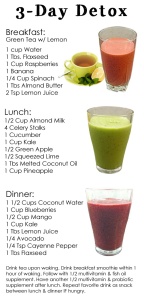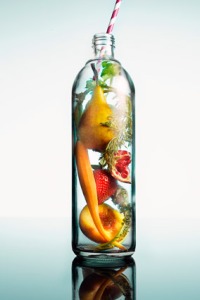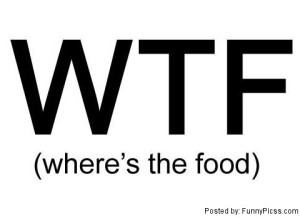One day I was at work, working on this very post (it was a slow day in science), and a friend asked what I was doing. I said I was answering questions that people had for me, and she replied with initial excitement that waned into reality: “Oooh you’re like Carrie Bradshaw! Except instead of writing about sex, you’re writing about science and nutrition. That’s not really as exciting.” No, it’s not. But here it goes – my attempt at being a columnist.
Q: What do you know of this Garcinia Cambogia and body cleanse diet. Dr. Oz has talked about it. Have you heard anything on it?
A: Like usual, when I saw “Dr. Oz” in the question, I cringed. I typically consider Dr. Oz to be a bit of an extremely charming snake oil salesman. But I decided to look it up because when the people have questions, I give them answers. First, I went to Dr. Oz’s website to see what him and his people had to say about it. Then I searched on PubMed to find out what the science says.
What Dr. Oz’s website says: Garcinia Cambogia is a fruit native to Indonesia and supplements are made from the rind of the fruit, which is high in a compound called hydroxycitric acid (HCA). The claim is that HCA prevents fat synthesis by blocking an enzyme (citrate lyase) that converts carbohydrates to fat. HCA also reduces appetite by increasing serotonin production in the brain. In effect, this improves mood and reduces the drive for emotional eating (though it is unclear if people with normal or high serotonin levels and who don’t resort to food to for emotional reasons would benefit from HCA).
What the science says: 43 Brazilian women who were overweight/obese were randomized to receive either a placebo or 2.4 g/day of G. Cambogia (separated into 800 mg consumed before each meal) in addition to an energy restricted diet (~1500 kcal/day) for 8 weeks. There were no differences pre- to post-treatment or between randomization groups following the study in terms of weight loss (or any other anthropometrics), or any marker of the lipid profile with the exception of triglycerides, which were lower after 8 weeks in the women consuming the supplement compared to those on the placebo. This study indicates no real benefit of using G. Cambogia. That’s just one example of a research study on G. Cambogia, but there are many more that show similar results. A recent review article by Astell et al. evaluated the data on a variety of plant extracts (including G. Cambogia) that have been explored in randomized controlled trials (the gold standard of human research) with regards to weight loss, and concluded that there is not sufficient data to suggest that any plant extract will significantly aid in weight loss above standard dietary and physical activity practices. One study did show that HCA taken in combination with Gymnema sylvestre extract resulted in a 5-6% reduction in body weight after 8 weeks.
The Bottom Line: There aren’t enough well designed research studies for this herbal supplement (or any) to get my stamp of approval. First, there isn’t enough information to suggest that they are effective, but more importantly, there is a question of safety here. People often use the logic that herbal supplements are “natural,” and therefore safe. But there is nothing “natural” about taking a supplement that provides you with 10 fold or more of a compound than what you would get from just eating food. Remember, hemlock is also “natural,” but it still very effectively killed Socrates.
Q: I have a friend who is using a mobile app to track his caloric intake and lose weight. He has lost weight, but I’ve noticed that he still eats pretty unhealthy food, drinks beer, and doesn’t seem like he’s getting any healthier, though he is still losing weight. Is he actually getting healthier?
This approach is similar to that of many fad diets, and it relies on the simple principles of “calories in, calories out.” Yes, if you ingest fewer calories than you expend, you will lose weight. This friend may actually be getting healthier because weight loss of as little as 5% of initial body weight has been proven to confer health benefits like improvement in blood lipids and glucose, blood pressure, sleep apnea, joint pain, depression, Type 2 diabetes, and you’re bound to reduce your risk of cardiovascular disease. Only 5%. That means that if you weigh 200 lbs and you lose 10 pounds, your health will most assuredly improve. Lose more weight, see more benefit. So the fact of the matter is, yes, health does improve when you lose weight (if you need to lose weight. This doesn’t hold true if you’re already a healthy weight). But this is not an approach I would ever recommend for anybody. While you will get healthier simply by losing weight but still eating whatever you want, it’s only a fraction of how healthy you could be if you started eating healthy foods. Matching the caloric content of two patterns, eating a whole foods diet that focuses on whole grains, fruits and vegetables, lean protein, and healthy fats will win out every single time over a diet high in refined carbohydrates, processed foods, and fatty protein sources.
There was a “case study” that a brave soul performed on himself to prove a point to his students. Professor of Human Nutrition at Kansas State University, Mark Haub, decided to go on a junk food diet for 10 weeks to prove the premise of “calories in, calories out.” He ate Hostess cakes, Doritos, Oreos, etc and consumed 1,800 calories/day (he should consume about 2,600 to maintain weight). While he did take a multivitamin and eat a couple of servings of vegetables everyday, his diet was mostly shit and he lost 27 lbs. A number of outcomes improved for him over the course of 10 weeks: his body fat percentage dropped, his blood lipids improved. (Read more about it here: http://www.cnn.com/2010/HEALTH/11/08/twinkie.diet.professor/).
The Bottom Line: So should you try to lose weight by simply focusing on calories? Like I said, not my recommendation. Haub’s data are interesting, sure, but we don’t know the long-term consequences of eating like that. I would speculate that the risk for cancer would increase, and inflammation and oxidative stress would be huge issues for Haub. Inflammation and oxidative stress are known to exacerbate chronic disease risk for diseases like cancer, Type 2 Diabetes, CVD, Alzheimer’s, etc. The outcomes that he measured are validated markers for disease risk, but they don’t tell the whole story. While obtaining/maintaining a healthy weight is extremely important for long-term health, there’s a lot more to it than just the number on the scale. Eat your damn produce.
Q: Is there any science to back up Ayurvedic eating practices?
A: Ayurveda is an ancient Indian approach to medicine, and Ayurvedic eating is a therapeutic approach to eating that is often practiced by yogis and others with goals of inner peace.
The focus of Ayurvedic eating is to find joy, balance, and an appreciation of food via eating. Most of Ayurvedic eating uses the same principles of mindful eating – being present, cooking your food, eating food that tastes good, paying attention to hunger cues, and not eating distractedly. In addition to mindful eating techniques, the practice considers three different body types and personalities (called “doshas”) – Vata, Pitta, and Kapha. Once you determine which dosha is predominant for you, you can start eating to complement it. I’ll go through everything for myself, but use this link to find out about yours, if you’re interested.
I determined that my primary dosha is Vata, which is fairly spot on with my body type and personality. The primary qualities of a Vata individual are that they thrive on movement and change. Vata individuals are typically tall and slender with narrow hips and shoulders and are generally energetic and enthusiastic, unless they are out of balance. Signs of being out of balance are skipping meals (something I try to avoid because I actually do notice how much it throws things out of whack for me – I don’t know if this actually has anything to do with being Vata or if that’s just my personality) and snacking constantly (my worst dietary habit!).
One of the predominant issues with Vata is digestion. To stay in balance, it’s recommended that Vata cook their food to ease digestive issues instead of eating foods (like vegetables) raw and heavier, oily, or warm foods are preferred. Vata should avoid red meat and many types of beans, but sweet, ripe fruits and many cooked vegetables are supported.
An interesting thing about Ayurvedic eating is that it focuses on eating a balanced diet, not only by balancing carbohydrates, protein, fats, vitamins, and minerals, but also taste. There are said to be six tastes – sweet, sour, salty, bitter, pungent, and astringent. Each meal should contain all six tastes in order to be balanced, though each dosha should focus on some more than others. For example, the Vata dosha should minimize bitter, pungent, and astringent flavors because these are said to lead to imbalance.
What the Science Says: I did look for some actual science to support this, but I didn’t find anything. This would be a pretty difficult thing to test, in general. First, I’m not sure what the outcome would be, other than quality of life. Ayurvedic eating is a healthy approach to eating, both due of the mindful eating approach as well as the focus on whole foods. This means that if you put the average person on an Ayurvedic diet, they would feel better because their diet in general has improved. You could probably put anyone one on any of the specific dosha diets and see improvements in health. In order to test it properly, you’d need to find people that already eat healthy, but perhaps don’t eat mindfully and don’t follow the recommendations of their particular dosha. It’s pretty difficult to properly measure a health outcome on people who are already healthy because the scale by which they can improve is drastically reduced.
The Bottom Line: While I couldn’t find any data to support Ayurvedic eating, that doesn’t mean it’s not a healthy approach to living. It just means that no one has tried to and/or effectively tested it yet. As I mentioned above, you’re likely to see benefit because of the mindful eating techniques as well as eating whole foods. As far as eating for your body type and personality – I don’t know. I can’t pinpoint a specific mechanism that would suggest that that’s necessary. But if you’re interested in it, give it a shot. It certainly won’t hurt you, and it looks like you may learn some interesting cooking techniques as it will force you to pay more attention to flavor pairing.
Hope that answers some burning questions that a few of you had and maybe the rest of you learned a thing or two along the way. I’ll post my final blog post within the next few days!



